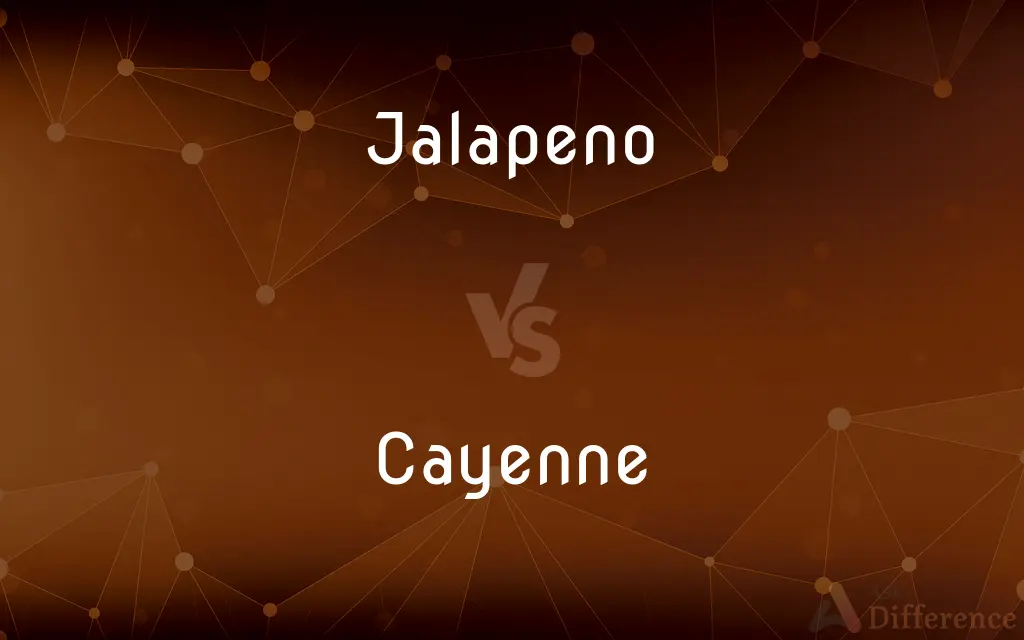Jalapeno vs. Cayenne — What's the Difference?
By Tayyaba Rehman & Fiza Rafique — Updated on April 16, 2024
Jalapeño peppers are milder and eaten fresh or cooked, while cayenne peppers are spicier and commonly dried and powdered.

Difference Between Jalapeno and Cayenne
Table of Contents
ADVERTISEMENT
Key Differences
Jalapeños are medium-sized, typically green or red, and have a Scoville heat unit range of 2,500 to 8,000, offering a mild to moderate heat. Whereas, cayenne peppers are long, thin, and red, and pack a much hotter punch with a Scoville rating of 30,000 to 50,000.
Jalapeños are often used fresh in salsas, stuffed dishes, or pickled, providing a crisp texture and a warm, biting flavor. On the other hand, cayenne peppers are usually dried and ground into a powder that is a key ingredient in various spice blends and hot sauces, contributing a sharp, fiery taste.
The flesh of jalapeños is thicker, making them ideal for grilling and stuffing. Conversely, cayenne peppers have a thinner flesh which dries quickly and is less suitable for these cooking methods.
Jalapeños are a staple in Mexican cuisine, enhancing the flavor of dishes without overwhelming them with spice. Whereas, cayenne peppers are often used in Indian and Creole cuisines, where they are appreciated for their intense heat and ability to boost metabolism.
Comparison Chart
Scoville Scale
2,500 - 8,000
30,000 - 50,000
ADVERTISEMENT
Color
Green turning to red as it matures
Bright red
Common Form
Fresh, cooked, or pickled
Dried and powdered
Culinary Use
Salsas, stuffed dishes, pickling
Spice blends, hot sauces
Cultural Association
Mexican cuisine
Indian and Creole cuisines
Compare with Definitions
Jalapeno
A medium-sized chili pepper known for its mild to moderate heat.
I diced some jalapeños to add a gentle spice to our homemade salsa.
Cayenne
Primarily used in its dried and powdered form.
Cayenne pepper is a key ingredient in my spice blend for barbecues.
Jalapeno
Often used in Mexican and Tex-Mex cuisines.
We stuffed the jalapeños with cheese and wrapped them in bacon for a delicious appetizer.
Cayenne
A long, thin chili pepper known for its high heat level.
I sprinkled some cayenne powder on the dish to make it spicier.
Jalapeno
Can be eaten fresh, cooked, or pickled.
I added some sliced jalapeños to my sandwich for an extra kick.
Cayenne
Common in Indian and Creole cooking.
Cayenne pepper adds significant heat to our Creole gumbo.
Jalapeno
Sometimes used in making spicy jams or jellies.
She made a batch of jalapeño jelly that was both sweet and spicy.
Cayenne
Often used in therapeutic remedies for its anti-inflammatory properties.
Cayenne ointment is applied topically to relieve joint pain.
Jalapeno
Jalapeños turn red and may become sweeter as they mature.
The red jalapeños in the garden are ready to be harvested and are slightly sweeter.
Cayenne
Known to boost metabolism and aid in digestion.
She adds cayenne to her morning lemon water as a metabolism booster.
Jalapeno
A cultivar of the tropical pepper Capsicum annuum having a very pungent green or red fruit.
Cayenne
Cayenne (; French pronunciation: [kajɛn] (listen)) is the capital city of French Guiana, an overseas region and department of France located in South America. The city stands on a former island at the mouth of the Cayenne River on the Atlantic coast.
Jalapeno
The fruit of this plant.
Cayenne
Ellipsis of cayenne pepper
What's the difference between a cayenne and a jalapeno?
His barbeque sauce could use a hint of cayenne to heat it up a bit.
Jalapeno
Alternative spelling of jalapeño
Cayenne
Spice in a figurative sense.
Jalapeno
Plant bearing very hot and finely tapering long peppers; usually red
Cayenne
Cayenne pepper.
Jalapeno
Hot green or red pepper of southwestern United States and Mexico
Cayenne
Plant bearing very hot and finely tapering long peppers; usually red
Cayenne
Ground pods and seeds of pungent red peppers of the genus Capsicum
Cayenne
A long and often twisted hot red pepper
Common Curiosities
What dishes are jalapeños commonly used in?
Jalapeños are commonly used in salsas, nachos, and as toppings on pizzas.
How hot are cayenne peppers?
Cayenne peppers are significantly hot, with a Scoville rating of 30,000 to 50,000.
What are the health benefits of cayenne pepper?
Cayenne peppers are known for boosting metabolism and having anti-inflammatory properties.
Are jalapeños hotter when they turn red?
Jalapeños can become slightly sweeter and milder as they turn red.
What is the typical size of a jalapeño pepper?
Jalapeño peppers typically grow between 2 to 3 inches in length.
How should jalapeños be stored to maintain freshness?
Jalapeños should be stored in the refrigerator in a plastic bag for up to a week.
Can you eat cayenne peppers fresh?
While cayenne peppers can be eaten fresh, they are most commonly consumed dried and powdered.
How are cayenne peppers used in weight loss?
The capsaicin in cayenne peppers is believed to boost metabolism, helping in weight loss.
Is cayenne pepper good for the heart?
Cayenne pepper can help in improving blood circulation and reducing heart disease risk.
What is a common misconception about cayenne pepper?
A common misconception is that cayenne pepper is only used for its heat, but it also has significant health benefits.
Can jalapeño plants be grown indoors?
Yes, with sufficient light, jalapeño plants can be grown indoors.
What are some alternatives to cayenne pepper in recipes?
Alternatives include red chili flakes and paprika, depending on the desired heat level.
Do jalapeños need to be peeled before cooking?
No, jalapeños do not need to be peeled before cooking; their skin is edible.
Can cayenne pepper aid in digestion?
Yes, cayenne pepper can stimulate the digestive tract and aid in digestion.
What are the best growing conditions for cayenne peppers?
Cayenne peppers thrive in hot, sunny climates with well-drained soil.
Share Your Discovery

Previous Comparison
Disease vs. Disorder
Next Comparison
Side vs. EdgeAuthor Spotlight
Written by
Tayyaba RehmanTayyaba Rehman is a distinguished writer, currently serving as a primary contributor to askdifference.com. As a researcher in semantics and etymology, Tayyaba's passion for the complexity of languages and their distinctions has found a perfect home on the platform. Tayyaba delves into the intricacies of language, distinguishing between commonly confused words and phrases, thereby providing clarity for readers worldwide.
Co-written by
Fiza RafiqueFiza Rafique is a skilled content writer at AskDifference.com, where she meticulously refines and enhances written pieces. Drawing from her vast editorial expertise, Fiza ensures clarity, accuracy, and precision in every article. Passionate about language, she continually seeks to elevate the quality of content for readers worldwide.














































